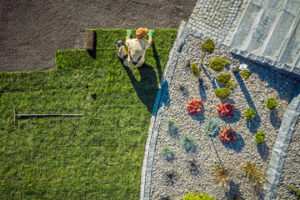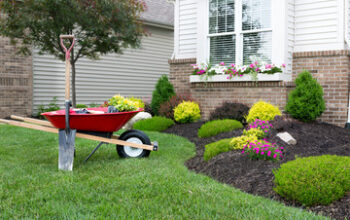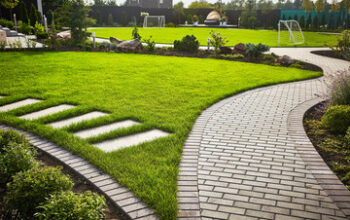Florence Landscaping adds beauty and value to your home or business while creating a tranquil escape. It also enhances the environment by reducing erosion, polluting runoff, and promoting biodiversity.
Strategic landscape design can provide a number of environmental benefits, such as energy efficiency. For example, trees placed properly can provide shade in summer and act as windbreaks in winter, lowering utility bills.
Plants are a vital component to any landscaping project. They provide color, texture, and seasonal variety to the outdoor space, as well as a natural filtration system for rainwater runoff. Additionally, they can help lower temperatures in concrete-dominant areas and protect water bodies from particulate pollution that reaches them from paved surfaces.
Landscape plants need to be chosen carefully to ensure that they are able to thrive in the climate and sun/moisture setting of the property. Choosing plants that are native to the area is best, as they will be adapted to the local soil and weather conditions. They will also be more resilient against disease and insect pests.
The form of the plant is another important factor to consider when selecting plants for a particular landscaping project. Plants come in many shapes and sizes, from the tall spiky shape of a cactus to the rounded form of a maple tree. For a more formal look, it is possible to use symmetrical plantings or neatly trimmed hedges. However, more informal landscaping can be accomplished with the use of a haphazard pattern of plantings that allow for plenty of room for growth.
A common trend in landscaping is the move toward sustainability. Sustainable landscaping involves the use of plants and other natural elements that require minimal maintenance to thrive. This type of landscaping is becoming increasingly popular because it is both environmentally friendly and economical. It is also becoming more of a necessity, as climate change becomes a major concern for many people. This type of landscaping uses smart gardening techniques to reduce the amount of water needed for upkeep, including grouping plants with similar water requirements and using drought-tolerant plants when appropriate.
Water
Water plays a crucial role in landscaping, from infusing life with its essential nutrients to reducing the heat island effect. It is also essential for creating intimate sanctuaries that promote relaxation and rejuvenation. The gentle sound of flowing water, whether a bubbling fountain or the trickling stream of a waterfall, helps mask noise and distractions to create an ambiance that encourages mental calmness. In addition, the visual and auditory stimuli of water features stimulate pleasure centers in the brain, fostering feelings of joy and contentment.
Despite its critical importance, water is becoming increasingly scarce. Global climate change, groundwater depletion, and increasing urbanization have strained our natural water resources. Landscapes that prioritize native planting, efficient irrigation and soil health can reduce their environmental impact and contribute to sustainable water conservation. Water-conserving practices such as educating homeowners about the appropriate watering requirements for different plants and implementing drip irrigation systems help to ensure that gardens remain thriving while being mindful of our limited water supply.
Plants need water for the process of photosynthesis, which is vital to their survival. Without it, they slowly starve due to a lack of Glucose, and this is why it is imperative that they are adequately watered on a regular basis. However, it is important to be aware of a plant’s specific watering needs as well as the rate at which it loses water through the process of evapotranspiration.
Incorporating water elements into the design of a landscape can be extremely versatile, offering limitless possibilities for aesthetics and sensory experience. Through a wide array of options and customization, water elements can transform into immersive environments that engage the senses and evoke a variety of emotional responses.
Lighting
When properly executed, lighting can be one of the most powerful elements of your landscape design. It can transform your outdoor spaces into mesmerizing nightscapes while enhancing safety around your home.
Landscape lighting is not an afterthought, but a vital element in your overall landscaping plan. It’s used to illuminate pathways and highlight focal points to create a warm, inviting feel. It can also help protect your property from vandalism and crime by deterring would-be intruders. Additionally, lighting can make it easier to navigate your yard after dark without tripping or falling over obstacles.
There are many ways to incorporate lighting into your landscape, including shadowing, washing, up-lighting and silhouetting. Shadowing is the process of placing lights behind objects to create a dramatic silhouette effect, while washing involves placing lights over surfaces like walls and fences to produce a soft glow that highlights texture and form. Up-lighting is another popular technique that draws attention to trees and statues by placing them at the base and angling them upward, creating striking silhouettes against the sky.
Accent lighting is also a popular option, using dimmable lights to spotlight key features in your garden. This type of lighting can be especially effective in highlighting a water feature, tree or other architectural feature. It can also be used to add a sense of drama or intrigue to your space, directing guests’ attention where you want it.
While there are many benefits to incorporating lighting into your landscape, it is important to remember that excessive artificial light can disrupt nocturnal ecosystems and harm wildlife. To minimize ecological disruption, it’s critical to use shielded fixtures that direct light downward and implement dimming technology when possible.
Structures
Form serves as the foundation of a landscape design, guiding all other components into a harmonious and unified setting. From the soft curves of blooming flowers to the defined edges of retaining walls, the arrangement of diverse forms is key to elevating landscapes into functional, beautiful settings. Skillfully integrating these shapes is crucial for crafting a unified landscape composition, which can be viewed from all angles and utilized by multiple senses.
Hardscape embodies the non-living, structural elements within a landscape design, bringing structure, delineation and purpose to outdoor spaces. From paths and patios to walls, decks and pergolas, these structures add visual interest to a garden with the use of a variety of materials like concrete, stone, wood, brick and more.
The way we shape elevation and structure directly influences how people experience a space. A subtle rise, a carefully placed planter or an expertly framed view can elevate perceptions and create emotional resonance. By pairing the rigidity of hardscape with the fluidity of softscape, designers craft enchanting outdoor sanctuaries that are as stunning as they are functional.
Trellises, trellis fences and arbors are versatile garden accents that can be customized to fit any style of landscaping. From a traditional and formal garden setting to a more modern or contemporary layout, these elements bring depth, dimension and intrigue to a space. The use of wood and other natural materials gives these elements a warm, rustic feel that complements any property and can serve as the focal point of a design. These features can be crafted with different styles of wood, metal and other materials to meet the individual needs of our clients. Adding these types of elements will enhance the functionality and beauty of your backyard, while adding value to your home.
Maintenance
Landscaping isn’t just about beauty—it’s also about function. Well-maintained landscapes promote biodiversity and preserve natural habitats by encouraging a variety of species to thrive, which reduces pest problems and helps sustain healthy soil.
In addition, constructing structures like retaining walls can help stabilize soil, prevent erosion, and protect homes or commercial buildings from damage caused by rainwater or floods. These benefits, along with others, make landscaping an integral part of any outdoor space.
For residential properties, well-maintained landscapes improve curb appeal and increase property value. Besides trimming bushes and maintaining lawns, landscaping services may include installing water features such as waterfalls, fountains, or koi ponds that introduce soothing sounds and movement into outdoor spaces. Additionally, hardscapes like patios, fire pits, custom concrete work, and walkways can create a seamless transition between indoor and outdoor living spaces.
Landscape maintenance is also important for businesses because it reflects a company’s commitment to environmental responsibility. For example, by using drought-tolerant plants and implementing efficient irrigation systems, companies can minimize water usage and energy consumption. Plus, maintaining a greener environment also helps reduce air pollution and greenhouse gas emissions, which makes it a win-win for everyone!
Ultimately, professional landscaping is all about creating functional and beautiful outdoor spaces that support an active lifestyle. It requires a deep understanding of both plant and soil health, as well as the ability to integrate both hardscape and softscape elements. Then, through regular upkeep, you can enjoy the fruits of your labor all year round.


